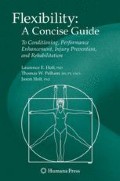Abstract
Although stretching traditionally has been viewed as a key component of sport and fitness conditioning, performance enhancement, injury prevention, and rehabilitation, there are many who currently believe it to be of limited practical value in any exercise or rehabilitation setting. Many myths regarding stretching and flexibility have been promulgated, and there is a growing confusion in the sport and exercise sciences, one that needs to be redressed. In this chapter, we expose the myths for what they are, defending a far more traditional, yet better justified perspective on the benefits of stretching.
Access this chapter
Tax calculation will be finalised at checkout
Purchases are for personal use only
Preview
Unable to display preview. Download preview PDF.
References
Herbert and Gabriel (2002), Shrier (2004), Nelson and Bandy (2005).
Holt et al. (1970), Holt (1974), Smith (1982), Holt and Smith (1983), Burke (1995), Holt et al. (1995), Culligan (1996), Holt et al. (1996a), Holt et al. (1996b), Holt et al. (1996c), Holt et al. (1999), Schmitt et al. (1998), Schmitt et al. (1999), Burke et al. (2000a), Burke et al. (2000b), Burke et al. (2000c), Burke et al. (2001), Holt and Pelham (2001), Pelham et al. (2001), Pelham et al. (2002a).
Herbert and Gabriel (2002).
Shrier (2002).
Halbertsma and Goeken (1994), Muir et al. (1999), Magnusson et al. (2000), Hunter et al. (2001).
Halbertsma and Goeken (1994), Carter et al. (2000), Shrier (2000), Bjorklund et al. (2001).
Wilson et al. (1991a).
Sahrmann (1996), Sahrmann (2002).
Sahrmann (2002) p 26.
Sahrmann (1996), Sahrmann (2002).
Sahrmann (1996), Sahrmann (2002).
Williams and Goldspink (1978), Williams and Goldspink (1984).
Smith (1982), Burke et al. (2000c).
McHugh et al. (1999).
Selby-Silverstein et al. (1997).
Shrier (1999; 2000; 2002; 2005).
Shrier (1999).
Pope et al. (2000).
Bandy and Irion (1994).
Hartig and Henderson (1999).
Amako et al. (2003).
Gans (1985), Reid (1988).
Jonhagen et al. (1994).
Kolber and Zepeda (2004).
Witvrouw et al. (2003).
Cross and Worrell (1999), cited by Nelson and Bandy (2005).
McKay et al. (2001).
Bixler and Jones (1992).
Krivickas and Feinberg (1996).
Dadebo et al. (2004).
Vad et al. (2003).
McArdle et al. (2000).
McArdle et al. (2001).
Herbert and Gabriel (2002).
Godges et al. (1989).
Alter (1996).
Alter (1996).
Brach and VanSwearingen (2002).
Nygaard et al. (1996).
Alter (1996).
Alter (1996).
Alter (1996).
Alter (1996).
Holt (2004).
Gilbert et al. (1998).
Fredericson et al. (2005), Malliaropoulos et al. (2004).
Kuukkanen and Malkia (2000).
Porter et al. (2002).
King et al. (2000).
Tyler et al. (2006).
Digiovanni et al. (2006).
Alter (1996), Cornelius and Hinson (1980), Etnyre and Abraham (1986), Hardy (1985), Holt and Smith (1983), Holt et al. (1970), Pelham et al. (2002a), Smith (1982).
Holt et al. (1995).
Author information
Authors and Affiliations
Rights and permissions
Copyright information
© 2008 Humana Press Inc., Totowa, NJ
About this chapter
Cite this chapter
Holt, L.E., Pelham, T.W., Holt, J. (2008). Myths About Stretching. In: Flexibility: A Concise Guide. Musculoskeletal Medicine. Humana Press. https://doi.org/10.1007/978-1-60327-105-9_9
Download citation
DOI: https://doi.org/10.1007/978-1-60327-105-9_9
Publisher Name: Humana Press
Print ISBN: 978-1-60327-104-2
Online ISBN: 978-1-60327-105-9
eBook Packages: MedicineMedicine (R0)

